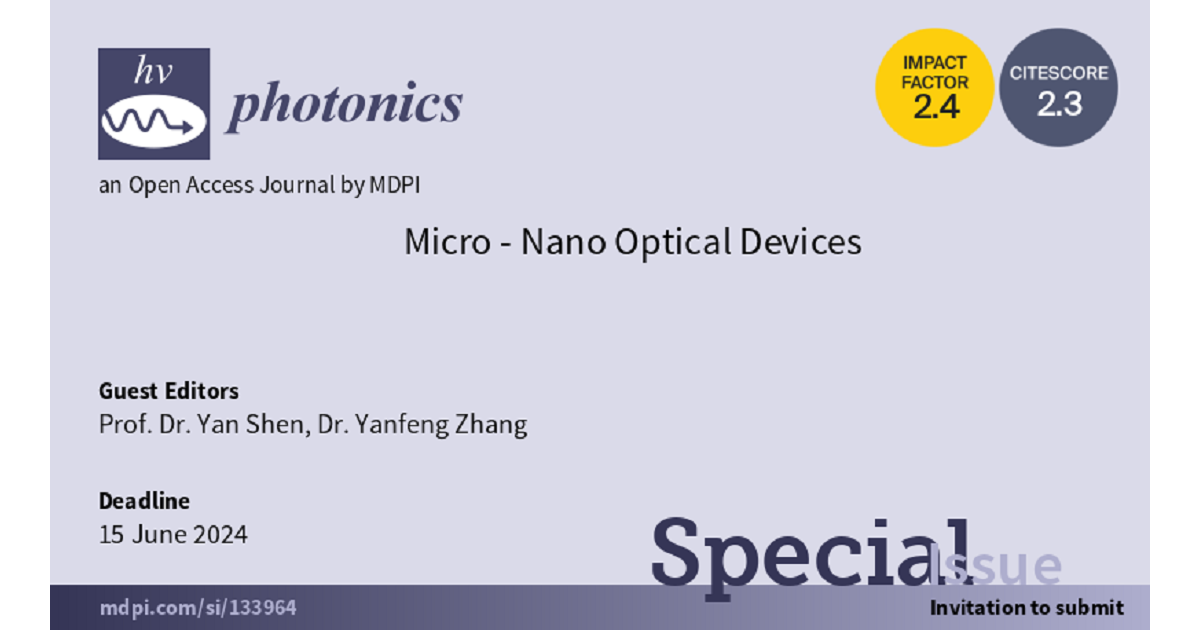Micro-Nano Optical Devices
A special issue of Photonics (ISSN 2304-6732). This special issue belongs to the section "Optoelectronics and Optical Materials".
Deadline for manuscript submissions: closed (15 June 2024) | Viewed by 37779

Special Issue Editors
Interests: nanophotonics; ultrafast photonics and electronics; terahertz radiation and detection; opto-electric characteristics of nanomaterials; deep ultraviolet source
Special Issue Information
Dear Colleagues,
This Special Issue invites manuscripts that document recent advances in “Micro-Nano-Optical Devices”. Since the concept of photonic crystal was proposed in 1987, various artificially constructed micro-nanophotonic structures and devices have attracted extensive attention and interest in several photonic research fields. The interaction of light and matter is becoming even more interesting now that the structure is breaking into the micro-nano regime. Micro-nano-optics combines the best of both photonics and nanotechnology. Micro-nano-optical devices are leading the development of the new optical electronic industry, in optical communications, optical interconnect, optical storage, imaging, sensing and measurement, display, solid state lighting, biomedical, security, green energy, etc. In this Special Issue, we will consider theoretical, numerical, and experimental papers that cover but are not limited to these topics:
- Advances in the design, fabrication, integration, and application of micro- and nano-optical structures, such as quantum wells, quantum dots, photonic crystals, nanowires, nanofibers, topology materials, metamaterials, waveguide, microcavity, gratings, etc.;
- Advances in light-matter interaction research and engineering of novel optical phenomena, such as exciton-polariton, surface plasmon–polariton, reflection, diffraction, refraction, interference, dispersion, cavity resonance, etc.;
- Progress in micro-nano-optical devices and systems for advanced applications, including optical communications, optical interconnect, optical storage, imaging, sensing and measurement, display, solid state lighting, biomedical, security, green energy, etc.;
- Photo-electric synergy, optoelectronic–matter interaction, and ultrafast electronics science and device applications.
Dr. Yan Shen
Dr. Yanfeng Zhang
Guest Editors
Manuscript Submission Information
Manuscripts should be submitted online at www.mdpi.com by registering and logging in to this website. Once you are registered, click here to go to the submission form. Manuscripts can be submitted until the deadline. All submissions that pass pre-check are peer-reviewed. Accepted papers will be published continuously in the journal (as soon as accepted) and will be listed together on the special issue website. Research articles, review articles as well as short communications are invited. For planned papers, a title and short abstract (about 250 words) can be sent to the Editorial Office for assessment.
Submitted manuscripts should not have been published previously, nor be under consideration for publication elsewhere (except conference proceedings papers). All manuscripts are thoroughly refereed through a single-blind peer-review process. A guide for authors and other relevant information for submission of manuscripts is available on the Instructions for Authors page. Photonics is an international peer-reviewed open access monthly journal published by MDPI.
Please visit the Instructions for Authors page before submitting a manuscript. The Article Processing Charge (APC) for publication in this open access journal is 2400 CHF (Swiss Francs). Submitted papers should be well formatted and use good English. Authors may use MDPI's English editing service prior to publication or during author revisions.
Keywords
- micro-nano-optical structures
- microcavity
- grating
- quantum dots
- quantum well
- lasers
- LEDS
- dispersion
Benefits of Publishing in a Special Issue
- Ease of navigation: Grouping papers by topic helps scholars navigate broad scope journals more efficiently.
- Greater discoverability: Special Issues support the reach and impact of scientific research. Articles in Special Issues are more discoverable and cited more frequently.
- Expansion of research network: Special Issues facilitate connections among authors, fostering scientific collaborations.
- External promotion: Articles in Special Issues are often promoted through the journal's social media, increasing their visibility.
- Reprint: MDPI Books provides the opportunity to republish successful Special Issues in book format, both online and in print.
Further information on MDPI's Special Issue policies can be found here.






